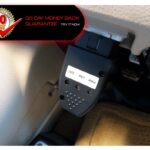Obd2 Dash Gauges provide a convenient way to monitor your vehicle’s vital signs in real-time. These digital gauges connect to your car’s OBD2 port, pulling data directly from the vehicle’s computer and displaying it on a compact screen. This article explores the benefits of OBD2 gauges, discusses popular options, and helps you choose the right one for your needs.
Understanding OBD2 Dash Gauges
OBD2 dash gauges offer a modern alternative to traditional analog gauges. They offer several advantages, including customizable displays, compact size, and the ability to monitor a wide range of parameters. These gauges can track metrics like coolant temperature, engine speed (RPM), vehicle speed, intake air temperature, and more, all without the need for complex wiring or multiple gauge installations. By leveraging the data stream from the OBD2 port, these devices provide a wealth of information at a glance.
Popular OBD2 Gauge Options
While the ScanGauge E, a popular choice for its compact design and affordability, has been discontinued, several viable alternatives exist. The ScanGauge II, though slightly more expensive, retains the compact form factor and offers expanded functionality. UltraGauge remains another contender, known for its user-friendly interface and budget-friendly price point. Numerous other OBD2 gauge options are available on Amazon and other online retailers, but it’s crucial to research their reliability and durability before purchasing. When considering an OBD2 gauge, factors like screen size, display customization, ease of installation, and data logging capabilities should be evaluated.
Choosing the Right OBD2 Gauge
Selecting the right OBD2 dash gauge depends on individual needs and preferences. For basic monitoring of essential parameters, a simple, compact gauge like the ScanGauge II or UltraGauge might suffice. However, if you require advanced features like data logging, performance monitoring, or diagnostic trouble code (DTC) reading, a more sophisticated gauge might be necessary. It’s important to consider factors like screen visibility in different lighting conditions, the range of parameters monitored, and the gauge’s overall build quality. If a minimalist approach is desired, a small, unobtrusive gauge is preferable. For users seeking extensive data and customization options, a larger display with programmable features would be more suitable.
Beyond Basic Gauges: Full OBD2 Gauge Cluster Replacements
For those seeking a complete overhaul of their vehicle’s instrumentation, full OBD2 gauge cluster replacements are available. These comprehensive systems replace the entire factory gauge cluster with a digital display, offering extensive customization and advanced features. However, these systems typically involve more complex installation and can be significantly more expensive than standalone OBD2 gauges. While offering a comprehensive solution, these replacements often constitute a more significant undertaking, potentially transforming a simple upgrade into a more involved project.
Conclusion
OBD2 dash gauges offer a valuable solution for monitoring vehicle performance and diagnosing potential issues. From compact, budget-friendly options to full gauge cluster replacements, the market offers a diverse range of choices to cater to various needs and budgets. By understanding your requirements and researching available options, you can select the perfect OBD2 dash gauge to enhance your driving experience. Choosing a hardwired option ensures consistent performance and avoids the potential connectivity issues associated with Bluetooth or app-based solutions.

